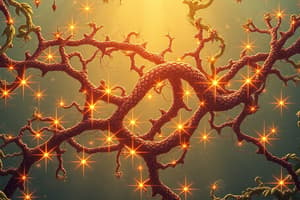Podcast
Questions and Answers
What characterizes exergonic reactions in metabolism?
What characterizes exergonic reactions in metabolism?
- They have a negative free energy change. (correct)
- They require continuous energy input.
- They consistently produce free energy.
- They are always enzyme-catalyzed.
Which of the following molecules is NOT primarily an energy-carrying molecule involved in metabolism?
Which of the following molecules is NOT primarily an energy-carrying molecule involved in metabolism?
- FADH2
- NADH (correct)
- ATP
- CTP
What is the primary role of enzymes in metabolic reactions?
What is the primary role of enzymes in metabolic reactions?
- They transform energy from one form to another.
- They catalyze reactions to support cellular functions. (correct)
- They increase the activation energy required for reactions.
- They initiate reactions without altering product yield.
Which statement is true regarding endergonic reactions?
Which statement is true regarding endergonic reactions?
What is a significant characteristic of metabolism described in the content?
What is a significant characteristic of metabolism described in the content?
What is a correct description of the reduction of NAD+?
What is a correct description of the reduction of NAD+?
Which enzyme class is involved in the reactions that produce NADH and FADH2?
Which enzyme class is involved in the reactions that produce NADH and FADH2?
What is the main function of phosphorylation in metabolic pathways?
What is the main function of phosphorylation in metabolic pathways?
Which of the following is NOT a phosphate donor mentioned?
Which of the following is NOT a phosphate donor mentioned?
What is formed from the sequential reduction of FAD+?
What is formed from the sequential reduction of FAD+?
What impact does a phosphate group have on hydrocarbon structures?
What impact does a phosphate group have on hydrocarbon structures?
Which statement best describes the relationship between oxidations and the enzymes involved?
Which statement best describes the relationship between oxidations and the enzymes involved?
In what context is thermodynamics considered complex in relation to metabolism?
In what context is thermodynamics considered complex in relation to metabolism?
Flashcards are hidden until you start studying
Study Notes
Introduction to Metabolism
- Metabolism is a complex and interconnected process that involves the interconversion of molecules.
- Metabolism produces reducing equivalents (NAD(P)H/FADH2), energy, building blocks for biomolecules, and storage forms for later use.
- Metabolism involves both exergonic (energy-releasing) and endergonic (energy-requiring) reactions.
- Enzymes catalyze the vast majority of metabolic reactions.
What you need to know...
- You are not expected to memorize chemical structures.
- You are expected to know reaction sequences and key points, such as the use and production of ATP and reducing equivalents.
- You are expected to know key regulatory points in pathways.
- You are expected to know relevant metabolic diseases.
- You are expected to apply your existing chemistry knowledge to this topic.
Reducing Equivalents
- NAD+ reduction involves the loss of a hydride ion and a proton by the reductant.
- FAD+ undergoes sequential reduction by hydrogen addition.
Enzyme Names
- Enzymes involved in NADH and FADH2 production are technically oxidoreductases.
- These enzymes are also known as dehydrogenases because they catalyze oxidation-reduction reactions involving the loss of hydrogen.
Phosphorylation Reactions
- Phosphorylation is a key metabolic event that can activate or destabilize a structure.
- Phosphate groups are large and electronegative, distorting hydrocarbon structures and making compounds easier to metabolize.
- Various phosphate donors are used, including ATP, GTP, UTP, and inorganic phosphate.
Thermodynamics
- Students are only expected to understand the information presented in the lecture.
Studying That Suits You
Use AI to generate personalized quizzes and flashcards to suit your learning preferences.




